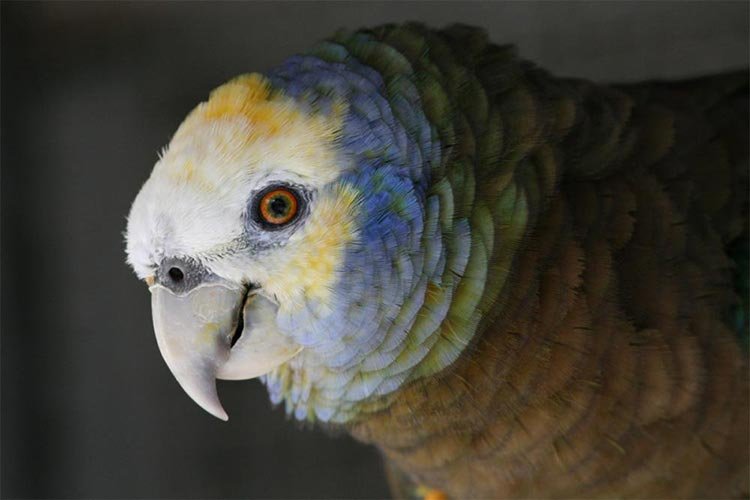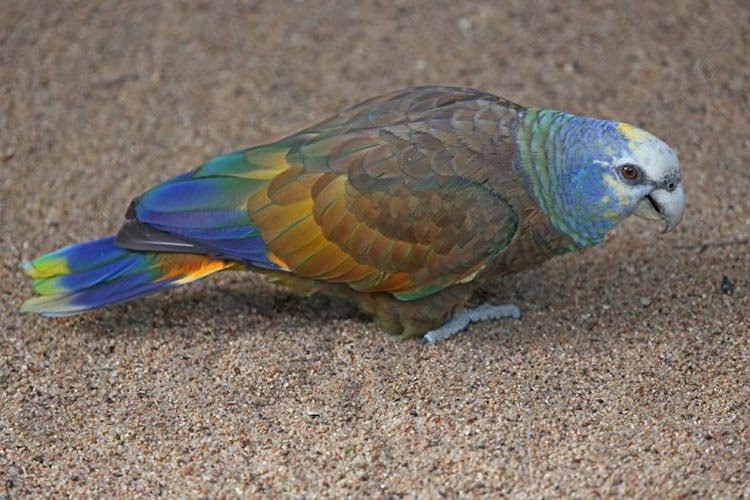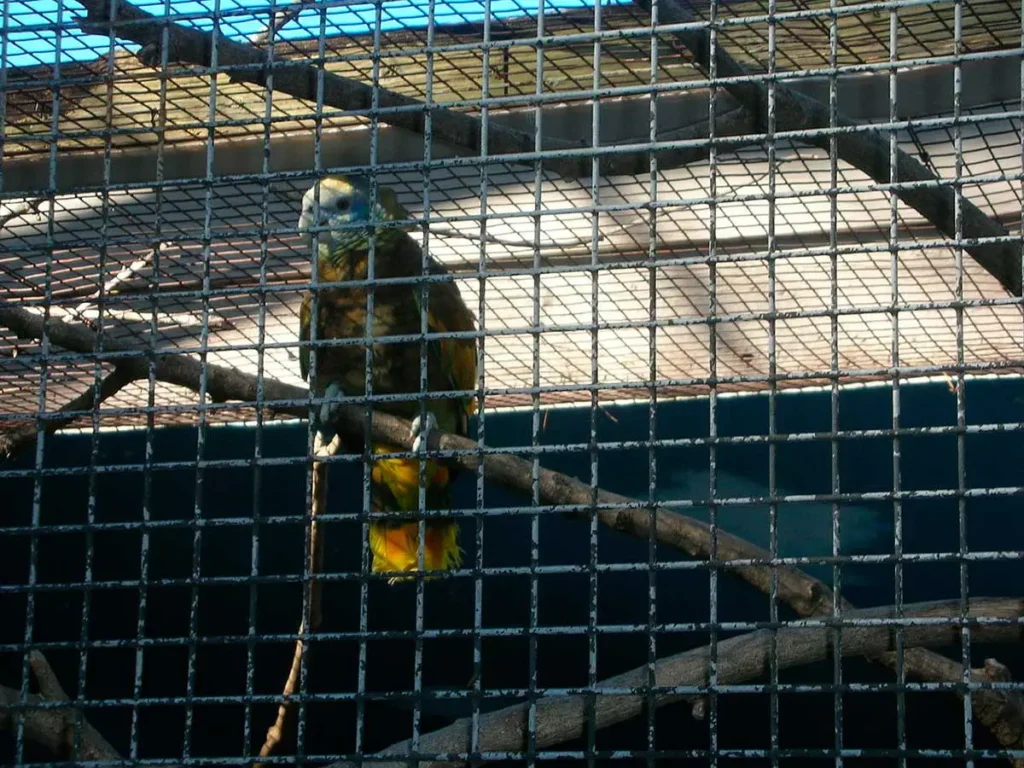
The Saint Vincent Amazon (Amazona guildingii), also known as the Vincent Parrot or St Vincent Parrot, is a rare and beautiful species of parrot endemic to the heavily forested mountains of the island of Saint Vincent in the Lesser Antilles. This multi-colored Amazon parrot is celebrated for its vibrant colors and striking appearance.
Overview of the Saint Vincent Parrot
Two Morphs: Common Green and Yellow-Brown
The Saint Vincent Parrot exhibits two morphs: the common green morph and the less common yellow-brown morph. The common green morph features a green head, greenish bronze upperparts, and violet blue green wings, while the yellow-brown morph has lighter plumage with more yellow and brown.
National Bird of Saint Vincent and the Grenadines
The St Vincent Parrot is the national bird of Saint Vincent and the Grenadines, symbolizing the rich biodiversity and cultural heritage of the island nation. The parrot is a source of pride for the Vincentian people and a reminder of the importance of preserving the natural beauty of their homeland.
Other Caribbean islands also have an amazon parrot as national bird, the Sisserou Parrot is the national bird of Dominica.
Habitat and Distribution
The St Vincent Parrot is found mainly on the island of Saint Vincent, where it inhabits the upper west and east ridges of the heavily forested mountains. The species prefers high-elevation habitats with large trees that provide suitable nest trees and ample food resources.

Physical Characteristics
Green Head and Violet Blue Green Wings
One of the most striking features of the St Vincent Parrot is its vibrant coloration. The green head and violet blue green wings of the common green morph make this parrot a stunning sight to behold. The violet blue feathers on the wings are edged with black, adding depth and contrast to the bird’s overall appearance.
Tail Feathers and Flight Feathers
The tail feathers of the Saint Vincent Amazon are equally striking, with broad yellow tips and a mix of green, blue, and bronze brown shades. The flight feathers are predominantly green with hints of blue and black, providing a beautiful contrast against the colorful body and tail.
Grey Feet and Reddish Eye
The Saint Vincent Amazon also has distinctive grey feet and a reddish eye, which further contribute to its unique appearance. These features, along with its colorful plumage, make the Saint Vincent Amazon a truly captivating bird to observe in the wild.
Behavior and Diet
Social Habits
The Saint Vincent Amazon is a social bird that often forms small flocks or family groups in the wild. These Vincent parrots are known for their loud, raucous calls, which can be heard echoing through the forest as they communicate with one another. They are most active during the early morning and late afternoon, when they can be seen flying between feeding and nesting sites.
Diet Consists of Seeds, Nuts, Fruits, and Flowers
The diet of the St Vincent Parrot consists primarily of seeds, nuts, fruits, and flowers. They are known to feed on many plants native to their island habitat, such as the seeds of large trees and the fruits of various shrubs and vines. The parrots play a vital role in seed dispersal, helping to maintain the health and diversity of their forest ecosystem.
Breeding and Reproduction
Breeding Season and Nesting Trees
The breeding season for the Saint Vincent Amazon Parrottypically occurs between January and July, with peak activity in March and April. During this time, the parrots seek out suitable nest trees, often selecting large, mature trees with natural cavities or hollows. However, nesting trees are often felled by trappers or undermined, causing large trees to collapse, which poses a threat to the Vincent Amazon parrot population. The nests are typically located high above the ground, providing protection from predators and offering a safe environment for the young birds and captive birds to grow and develop.
Reproductive Biology and Parental Care
The female St Vincent Parrot lays 2-4 eggs, which are incubated for about 26-28 days. Both parents share the responsibility of incubating the eggs and caring for the hatchlings, with the male primarily responsible for bringing food to the nest. The young birds fledge at around 10 weeks of age, and will continue to be cared for by their parents for several months as they learn to fly and forage for food.

Conservation and Threats
Habitat Loss and Fragmentation
The Saint Vincent Amazon faces numerous threats to its survival, with habitat loss and fragmentation being the principal causes. Deforestation rates have increased due to forestry activities, banana cultivation, and charcoal production, which destroys large areas of suitable habitat and isolates populations. This genetic isolation can lead to inbreeding and further cause species decline.
Illegal Trade and Cage Bird Trade
Another significant threat to the St Vincent Parrot is the illegal trade in wild-caught birds for the cage bird trade. Trappers seeking young birds often target nesting trees, which are felled to capture the young parrots. This not only depletes the wild population but also destroys critical nesting sites for future generations.
Natural Events and Threatened Species
Natural events, such as hurricanes and volcanic eruptions, also pose a threat to the Saint Vincent Amazon. The small population size and limited distribution of the species make it particularly vulnerable to the impacts of these natural disasters. As a result, the St Vincent Parrot is considered a threatened species, with a very high risk of extinction in the wild.
Conservation Programs and Efforts
Breeding Programs and Facilities
In response to the threats faced by the Saint Vincent Amazon parrot, several conservation programs have been established to help protect and preserve the species. One such effort is the establishment of breeding facilities, such as the Nicholas Wildlife Aviary Complex and the Houston Zoo, which focus on vital captive breeding programs to bolster the wild population. These facilities work in partnership with local and international conservation organizations to ensure the long-term survival of the St Vincent Parrot .
Conservation Organizations and Government Involvement
Conservation organizations, such as the Forestry Department of Saint Vincent and the Grenadines and the Graeme Hall Sanctuary, are working tirelessly to protect the St Vincent Amazon and its habitat. They engage in habitat restoration, nest monitoring, and public awareness campaigns to educate the local community about the importance of the species and the threats it faces.
The Saint Vincent government has also recognized the importance of the St Vincent Amazon to the nation’s biodiversity and cultural heritage. They have implemented strict regulations to protect the species, including the enforcement of Appendix I of the Convention on International Trade in Endangered Species of Wild Fauna and Flora (CITES), which prohibits international trade in wild-caught birds.

Conclusion
The St Vincent Parrot is a stunning and unique species of parrot that captivates all who have the privilege of encountering it in the wild. However, the numerous threats it faces, including habitat loss, illegal trade, and natural disasters, have placed it at high risk of extinction. Through the combined efforts of conservation organizations, breeding facilities, and government involvement, there is hope that the St Vincent Amazon can continue to thrive and flourish in its native habitat for generations to come. By raising awareness about the importance of this beautiful bird and supporting conservation efforts, we can all play a part in ensuring its survival and the preservation of the rich biodiversity of Saint Vincent and the Grenadines.
